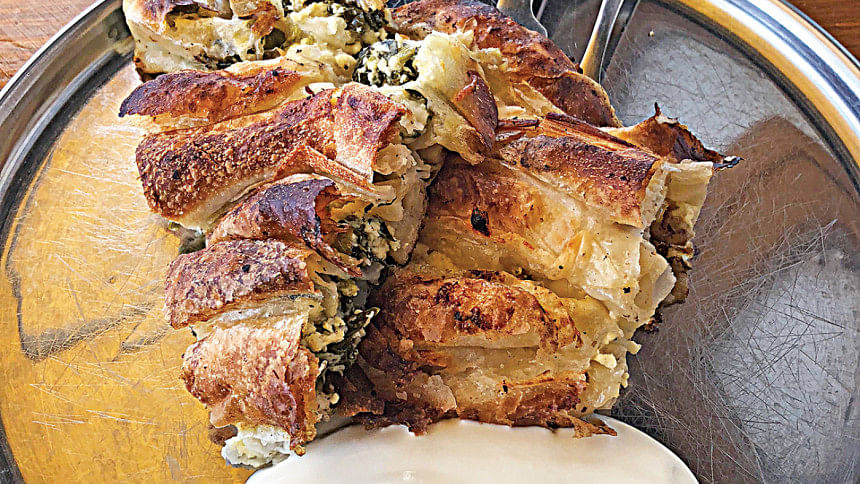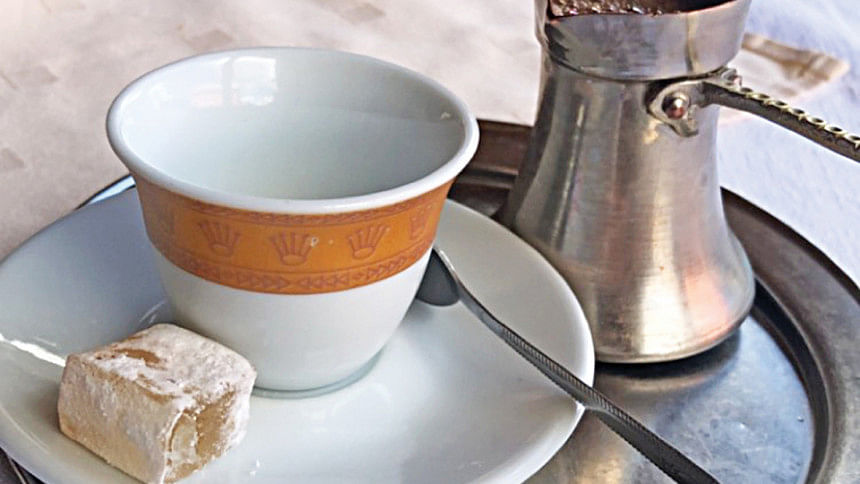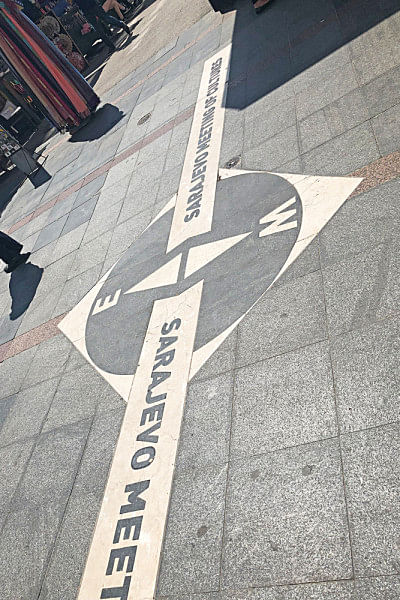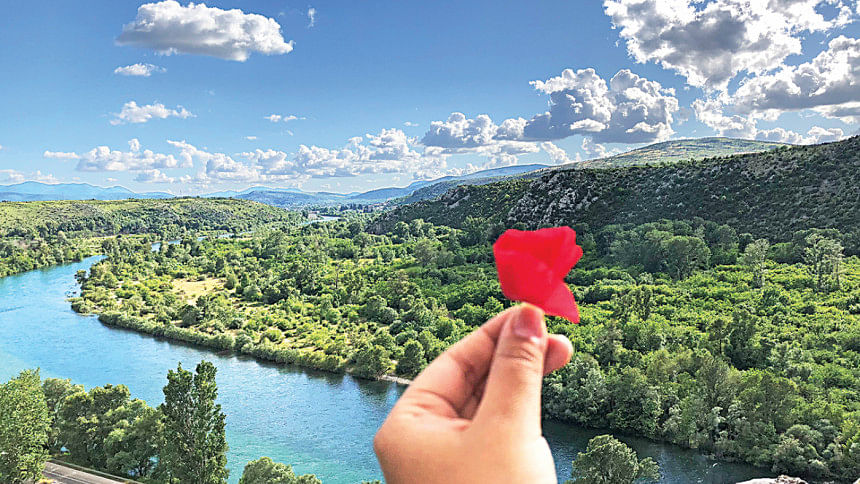Bengali girl in Bosnia

When I was 12 years old, I was a wide-eyed girl in sixth-grade history class, learning about the First World War—how the assassination of Archduke Franz Ferdinand by a young man by the name of Gavrillo Princip triggered a war in Europe and plunged the world into chaos. That incident took place in Sarajevo, the capital of Bosnia. I had known only two things about Bosnia up until that point—first, that there is a kind of fried bread in Bangladesh which is referred to as Bosnian Bread and second, that there was a war of some sort in Bosnia in more recent history.
Over time, I became more invested in learning about the Balkans. I made my way through Bulgaria, Romania and Slovenia in 2016 and finally to Bosnia in 2018. I used my multiple entry Schengen visa to enter Bosnia as the country allows tourists with a proxy EU, Schengen or US visa to visit for up to 90 days.

Sarajevo:
On my first day, I took a stroll around the centre of the old part of town, where I was staying. It was beautiful, lively and happy. The next morning, I woke early and made my way to the walking tour, where I not only learnt about Sarajevo but about Bosnia in general. Sarajevo is truly the point where the East meets West; in fact, there is an exact point in one street at the city centre where the architecture changes from Ottoman to Austro-Hungarian. If you walk east from there, you will come across the most famous fountain in Sarajevo. Legend has it, if you drink the water from this fountain, you are bound to come back to Sarajevo. I hope this is true, because I intend to keep coming back to this wonderful city.
There is a street in old town which is renowned for its food. This street is home to Buregdžinica Bosna, which serves the best Burek in the world. Burek is a thin crispy layered pastry filled with cheese, spinach, pumpkin or meat and is served with a heap of sour cream—and it is delicious! I was also told by several people that the street also hosts the best Cevapi, which is basically Balkan kebabs. I didn't get a chance to taste it, but trust the locals if you're a fan of meat.

Stroll up Mount Trebevi to the white and yellow fortresses to have a great view of the city. This spot is where the cable car into the mountain used to operate, until the operator of the cable car was the first casualty at the hands of the Serb forces in the Bosnian war. The seige on Sarajevo started a few weeks later, on April 5, 1992, and lasted for 1,425-days—making it the longest blockade of a capital in modern history. The spot was then occupied by snipers from the Serbian forces, who shot and killed civilians in the city. However, in 2018, 26 years after the Seige of Sarajevo, the cable car was once again reopened for tourist use. I did not use the cable car—I hiked up to the mountain—but you can do so for 20 marks.

Sarajevo is distinct in many ways. For one, it makes no attempts to hide the signs of war. You see the bullet holes all over the city, as well as the signs of the extended siege that was enforced on the country. Something unique to the city is how it transformed the remnants of war to something of remembrance. One such sign is the Sarajevo Rose. The Sarajevo Rose is a splatter of red on the streets where civilians were killed during the war by the Serb forces. The splatter is that of mortar shells hitting the ground, filled in with red resin and turned into a flower. But of the many things distinct about Sarajevo, what stands out most is perhaps coexistence. Within a stones throw away of each other, you will see a mosque, a synagogue, a catholic church and an Orthodox church, representing all the major religions within the country.

Travnik and Jajce
From Sarajevo, I took a bus up to Travnik, the old capital of Bosnia. The bus costs around 13 marks which is equivalent to 7.5 euros. I had a three-hour break at the stop where I dropped off my bag and decided to roam around the streets. The people there are more than happy to store your bag free of charge. Travnik, like most other Bosnian cities, is nestled in between the mountains. Next to a stream of rapids is a small restaurant serving top-notch Cevapi, something I had to miss as I do not eat red meat.
But it is still a top recommendation. I eventually made it to Jajce, a tiny town which made me fall head over heels in love with in a moment's notice.
The bus ticket from Travnik to Jajce will set you back another 13 marks. It is a small hike from the bus stop to my place of stay. The hike to my residence was well worth it because the city is centred around a gushing waterfall. God was generous when it comes to bestowing Bosnia with natural beauty. There is even a tiny museum showcasing the magic and culture of the tiny medieval town.

No one will be starved for activity here. The city has catacombs and also promises long, winding walks through parks that lead to a mini forest, all ending up at the cascading waterfalls. I stayed in a small room in a family-owned hotel with a view overlooking the mosque and became fast friends with the amicable Bosnian owner. Jajce was the place where I learnt to really tap into my language skills and take a step out of my comfort zone to try and speak German in order to communicate.

Bihac
The bus from Jajce to Bihac cost 23 marks and took a good few hours. A border town to Croatia, Bihac is stunning and is often the place people stay at when they are visiting Plitvice National Park. I was there to visit the River Una, though. I swam in the river, took a walk around the city, went on a canoe trip and by evening I was back to drink coffee with the locals. My lasting memory of Bihac is the sheer kindness with which everyone approaches you. I was the only foreigner around and people went out of their way to make sure I was comfortable in their little town. Bihac is far up north in Bosnia. And from there I made my way down to the southern part of the country, Mostar.
Mostar
To get to Mostar, I took a bus from Bihac to Donji Vakuf and eventually to Mostar. It took an entire day to get to my destination as it involved losing my way in between. The entire journey to Mostar will set you back 45 marks but if you want to skip the journey up north, you can take the famously picturesque train from Sarajevo to Mostar for a much cheaper and quicker journey, but then you would miss out on the beauty of the north.

In Mostar, I stayed at a place called Majda's hostel where I made wonderful friends with whom I travelled to Montenegro and took a tour around Hercegovina. What is central to the city of Mostar is the Stari Most Bridge, translated to "old bridge" in English. The bridge connects two crucial parts of the city with each other with a river running in between. The bridge stood for hundreds of years until the war. The bridge was rebuilt once the war was over.
Mostar is also home to the beautiful waterfall Kravice (translation: cows). You can take a swim in the freezing waters here and my friends and I did take the dip in the 15-degree water. The most photographed spot of the country is the Blagaj Tekkia (Blagaj Monastery), home to dervishes for hundreds of years. The monastery is almost completely tucked into the mountain and above it is a spot renowned for having incredible meditative energy. People from across the world come here to meditate. The monastery was built in the 16th century and is situated at the source of enchanting Buna river. Legend has it, if you drink the water from the river, your wishes will come true. So of course, I drank the water—crisp and cold to the taste. It was also there that I learnt that Azerbaijanis brought Islam to Bosnia as far back as the 14th century before the Ottoman empire conquered Bosnia.
Bosnia is also known as the heart shaped country, mostly because of the way the map is shaped, but I can also imagine another riason. Bosnian hospitality is like no other I have experienced. At each turn, they went out of their way to welcome me into their homes and their lives.
Maliha Fairooz is a 28-year-old Bangladeshi solo traveller, who has travelled to 85 countries, on a Bangladeshi passport. Through her blog www.maliharoundtheworld.com she shares her experience of travelling as a brown, Muslim, Bangladeshi woman while simultaneously encouraging a culture of travel amongst Bangladeshi youth.

 For all latest news, follow The Daily Star's Google News channel.
For all latest news, follow The Daily Star's Google News channel. 



Comments